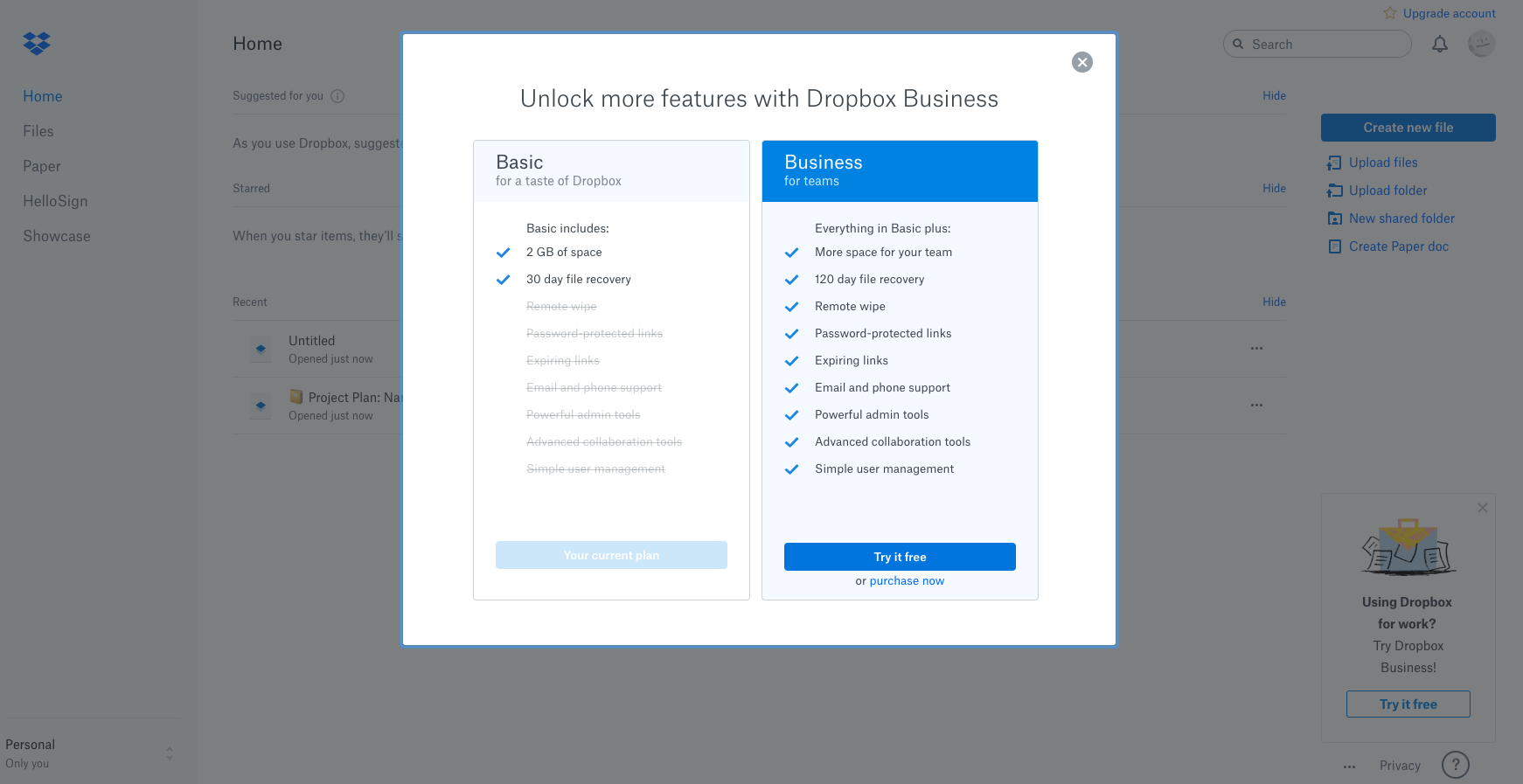Most legacy B2B tools are slow, complicated, and come with lengthy instruction manuals and a dedicated, outsourced help desk.
In 2019, it’s no longer enough to expect end users to adopt whatever tool you give them, regardless of the experience they offer. When best-in-class user experiences can be downloaded in the App Store for free, people don’t just want the software they use at work to have great UX, they’ve come to expect and demand it.
The rise of consumer-grade UX
B2B user expectations have changed. To be competitive in the 2019 SaaS landscape, you need to align the way you develop your app with what users want, rather than expecting them to fall in line with what you can deliver. And what B2B users want is consumer-grade UX.
More specifically, people now expect the tools they use at work to be:
- Intuitive—Users want their products to “know” what they want to do next, and help them get there quickly through on-screen prompts and in-app messaging.
- Personalized—Users want an experience that is tailored to their behavior, likes and dislikes, and individual requirements and use cases.
- Mobile—The mobile version of your software shouldn’t look just like your desktop or web product. Give your users an app that is tailored to the kind of actions people take on a small screen, such as pinch and zoom, and different modalities like voice and touch.
- Fast—In 2019, people just don’t have the patience for slow load times.
- Agile—Consumers want regular, incremental updates based on their feedback, not a yearly download that takes hours to install.
And providing a consumer-grade user experience isn’t about packing in every cool feature imaginable. People buy and use your product for a reason—ultimately, they expect your software to make their lives easier or better in whatever way you’ve promised. Consumer-grade products don’t just deliver value, they make it easier for users to achieve that value for themselves.
The transition to product-led
The consumerization of enterprise software has also led to a shift in sales models. When it comes to product choice and adoption, the C-Suite is no longer calling all the shots.
Michael B. Gilroy, a partner at early-stage VC firm Canaan, explains how this shift is affecting the way SaaS products are purchased and adopted:
“Just as enterprise software shifted from on-premise to SaaS, we’re in the midst of another shift... from enterprise sales & deployment (top-down) to consumerization sales & deployment (bottom-up).”
Take Dropbox as a case in point: The company generates more than 90% of its revenue from self-serve channels —users who purchase a subscription through its app or website.
And in 2017, more than 40% of new Dropbox Business teams included a member who was previously a subscriber to one of its individual paid plans.

Guilherme Lopes, co-founder of digital marketing company ResDigitais, explains:
“We’ve seen more and more of the currently fastest growing SaaS using the PLG [product-led growth] strategy. Companies like Zoom, Slack, Dropbox, and others are making their product the main source of demand generation. Not only [are] those companies killing it in customer experience, but they are also reshaping the sales process.”
For legacy B2B companies, a transition away from sales-led and marketing-led strategies is a daunting task. But to build and sell enterprise products to a modern market, embracing a product-led growth model is essential.
This involves offering freemium or free trial versions of your software to allow users to explore your product before purchasing.
The exciting part about this model is that, because they have already used your product and voluntarily adopted it, product-qualified leads (PQLs) are primed and ready for a sales touch. And buyers who come in through a freemium plan or free trial have made an educated decision and are less likely to churn in favor of a competitor’s product.
The role of onboarding in consumer-grade UX
A product-led strategy is only viable if you can deliver a delightful user experience that not only helps users succeed but also allows them to see your product’s value quickly and without hand-holding.
This is where user onboarding comes in. People no longer accept the idea that they need implementation specialists to set up software or tailor it to their roles and use cases. Nobody wants to spend hours in training to learn how to use B2B software. They want to be able to explore new a product for themselves, and see its value within the first use.
So it’s time to throw the user manuals in the recycling bin and replace them with succinct and contextual product tours, walkthroughs, checklists, and in-app nudges. Show new users how your tool can add value and solve their problems by walking them through key features and workflows. But make it short and snappy—you have a limited amount of time to prove the value of your app and users don’t want or need to know about every single tiny thing it can do.
Engage users through the product itself
User engagement, retention, and satisfaction are key metrics for any consumer-grade product. One of the simplest ways to improve all 3 is to optimize your in-app messaging and improve communication with your users through your product itself.
Improve free-to-paid conversion
In-app messaging drives long-term engagement by encouraging feature adoption and habit-building around certain user behaviors. Whether during initial onboarding, a new feature announcement, or regular product usage, your in-app messaging should be focused on guiding users toward value.
Take blogging platform Ghost, for example. After analyzing their own data, they realized that new users who accomplish a certain task (adding a custom blog theme) were 10x more likely to subscribe to a paid account.

So they optimized their onboarding sequence to encourage users to add a custom blog theme and dramatically improved conversion.

Personalization and segmentation
You can increase the relevancy of in-app messages by segmenting users according to where they are in their user journey or by the features and tools they need for their roles. You can also segment users using user data and AI to personalize messages according to user information and the specific action they are trying to carry out.

Self-service support
Nobody likes sitting on hold with customer support. Even emailing a product company to ask for help can feel like too much effort on a busy day. People want—and have come to expect—self-serve support that automatically detects when they might be encountering a problem and leads them to the solution via chatbots or contextual, timely in-app messages.

Product-led companies invest in the user experience
What does the consumerization of enterprise really mean? It means creating products that people actually enjoy using—products that deliver value through the products themselves. It means starting down the path to a product-led growth strategy and recognizing that a great UX should be a business goal in and of itself.
If you want to stay competitive in this economic climate, leading with experience is now table stakes. In a 2023 survey of 350 SaaS professionals, we learned 88% view product-led experiences as crucial to competing and differentiating in the market—and a whopping 97% are actively investing in delivering a more product-led experience.

Want to learn more about the journey to product-led growth? Head on over to the Product-Led Growth Collective—a place where like-minded product folks talk shop, swap insights, and share stories from their own journeys to becoming product-led.











